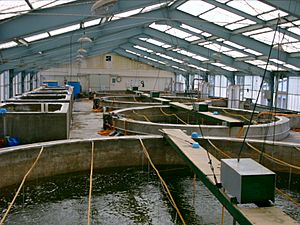Fish hatchery facts for kids
A fish hatchery is like a special farm for baby fish and shellfish. It's a place where fish eggs are carefully hatched, and the young fish (called larvae or juveniles) are raised during their early life.
These hatcheries mostly produce young fish, shellfish, and crustaceans (like shrimp) for the aquaculture industry. Aquaculture is basically farming in water. Once the baby animals are big enough, they are moved to larger fish farms to grow until they are ready to be harvested.
Some common animals raised in these hatcheries include Pacific oysters, shrimp, Indian prawns, salmon, tilapia, and scallops.
Fish hatcheries also help with smaller, local needs, especially in places like South-East Asia. They are also important for conservation programs, which means helping to protect native fish species. For example, the U.S. Fish and Wildlife Service has a system of national fish hatcheries to help save different kinds of fish.
Hatchery Design
Hatcheries can look very different depending on what they are used for, where they are located, and what kind of animals they are raising. Some hatcheries are small and are part of bigger fish farms. Others might only produce young fish to sell to other farms.
Very small hatcheries might even supply fish to families or communities, especially in South-East Asia. A small hatchery usually has tanks for raising baby fish, filters to keep the water clean, tanks for growing live food for the young fish, and a system for fresh water.
A larger, commercial hatchery would have many more areas. This includes a place for adult fish to lay eggs (called broodstock holding and spawning), a facility to grow food for the young fish, areas for raising larvae and juveniles, water pump systems, a laboratory, a quarantine area (to keep sick fish separate), and offices.
Costs of Running a Hatchery
The biggest cost in running a fish hatchery is usually paying the people who work there. This can be more than half of all the money spent.
Genetic Concerns
Hatcheries can sometimes face challenges related to genetics, which is about how traits are passed down through generations.
First, if a hatchery uses only a small number of parent fish (broodstock), it can lead to inbreeding. This is like family members having babies, which can make the fish weaker or less healthy over time.
Second, even if there are many parent fish, the young fish raised in a hatchery might have less genetic variety compared to fish in the wild. If these hatchery-raised fish escape into the wild or are released, they could affect the wild fish populations. This is especially a concern if the escaped fish have been specially bred or genetically modified.
Third, some people are concerned about changing the genes of food animals. This is called genetic modification, and it's a topic many people have strong feelings about.
Images for kids






